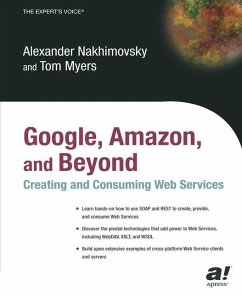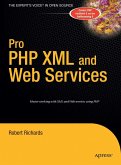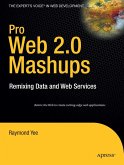While many books are focused on the underlying technologies of Web Services and others are dedicated to providing Web Services, few books show how to consume Web Services. This new book, Google, Amazon and Beyond: Creating and Consuming Web Services, provides a thorough review of the technologies and techniques for connecting client applications to services of all kinds. Using a decidedly hands-on approach, the authors show extensive examples of programming with XML, SOAP, WSDL, and UDDI in a variety of programming languages.
Technology involved: Java, Perl, XML, XSLT, WSDL, SOAP, XML-RPC, UDDI, JavaScript, .NET, JSP, RSS.
What Is This Book About? This is a book about Web Services. Web Services are still more like a movement than a mature technology. The movement is motivated by a vision of a semi-auto mated Web that can support long chains of interactions between autonomous agents. There are three important components to that vision. One is interoperabil ity: a service can have clients (agents) from any platform, in any language. Another is autonomy: an agent can discover the services it needs from their published descriptions that include both what the service can do and how it does it (the interfaces of available actions). The third is (semi) automatic code creation: one description can be used by a development framework to automate the creation of code for clients and by the services themselves. As of today, interoperability is close to full realization, with only occasional glitches; autonomy is a distant vision; but it still has problems. Interoperability has been achieved code creation is useful in part by using an XML-based high-level protocol (SOAP) for message exchanges between clients and services. As long as the client can produce messages in the right format, it doesn't matter what language they're written in or on what platform they run. The first three chapters of our book show how to write platform-independent Web Services clients in Javascript and Java running from within a browser (IE6 or Mozilla).
Hinweis: Dieser Artikel kann nur an eine deutsche Lieferadresse ausgeliefert werden.
Technology involved: Java, Perl, XML, XSLT, WSDL, SOAP, XML-RPC, UDDI, JavaScript, .NET, JSP, RSS.
What Is This Book About? This is a book about Web Services. Web Services are still more like a movement than a mature technology. The movement is motivated by a vision of a semi-auto mated Web that can support long chains of interactions between autonomous agents. There are three important components to that vision. One is interoperabil ity: a service can have clients (agents) from any platform, in any language. Another is autonomy: an agent can discover the services it needs from their published descriptions that include both what the service can do and how it does it (the interfaces of available actions). The third is (semi) automatic code creation: one description can be used by a development framework to automate the creation of code for clients and by the services themselves. As of today, interoperability is close to full realization, with only occasional glitches; autonomy is a distant vision; but it still has problems. Interoperability has been achieved code creation is useful in part by using an XML-based high-level protocol (SOAP) for message exchanges between clients and services. As long as the client can produce messages in the right format, it doesn't matter what language they're written in or on what platform they run. The first three chapters of our book show how to write platform-independent Web Services clients in Javascript and Java running from within a browser (IE6 or Mozilla).
Hinweis: Dieser Artikel kann nur an eine deutsche Lieferadresse ausgeliefert werden.
From the reviews:
"In contrast to a great many other books on web services, this book is structured firmly around what is out there and what works. ... A number of extended examples are used in the book ... . This extended example brings together many of the topics that are covered separately. ... the book also provides much useful additional, but essential, material. ... Overall then, this is a useful book ... . the reader can very quickly get up to speed and start experimenting." (TechBook - Report - online, March, 2004)
"In contrast to a great many other books on web services, this book is structured firmly around what is out there and what works. ... A number of extended examples are used in the book ... . This extended example brings together many of the topics that are covered separately. ... the book also provides much useful additional, but essential, material. ... Overall then, this is a useful book ... . the reader can very quickly get up to speed and start experimenting." (TechBook - Report - online, March, 2004)







